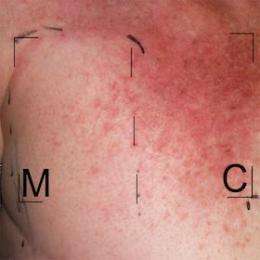The dressing has been applied to one side (M). The difference in skin reaction is apparent.
(Medical Xpress)—Skin reactions following radiation therapy for breast cancer have been the focus of a recent clinical trial conducted by Dr Patries Herst from the Department of Radiation Therapy, University of Otago, Wellington and a team of radiation therapists in public hospitals in Dunedin, Wellington and Palmerston North and Auckland Radiation Oncology.
The findings of the study, recently published in the international journal Cancer Science and Therapy, show that silicone based dressings decrease painful skin reactions caused by radiation therapy better than conventional aqueous cream.
The randomised controlled trial investigated the effect of silicone based Mepilex Lite dressings on the severity of painful skin reactions experienced by 80 women treated with radiation therapy for breast cancer. The affected skin was divided into two equal halves; one half was randomized to be treated with dressings and the other with aqueous control cream.
The dressings decreased both the visible signs of the skin reactions as well as the severity of the symptoms. Most patients preferred the dressings over the cream and found them easy to use and comfortable to wear.
"These results will be of great benefit to people undergoing radiation therapy for breast and head and neck cancers as radiation can cause severe skin reactions by damaging the cells responsible for skin renewal and this really impacts on their quality of life," says lead researcher Dr Patries Herst.
The severity of the reactions varies from redness to flaking to weeping and ulceration. Severe skin reactions are extremely painful particularly in places where clothing rubs and presses on the damaged skin. There is currently no standard treatment for these skin reactions.
The dressings do not contain any chemicals but stop friction between the fragile skin and clothing, giving the radiation damaged skin time to heal. A very thin layer of silicon allows the dressings to stick closely to healthy skin but not to weeping skin, making them easy and painless to remove.
Dr Herst is continuing her investigations into the use of these dressings and hopes that they will become part of standard skin care in radiation therapy departments in New Zealand in the near future.
Breast cancer is the most common malignancy in New Zealand women; around 2800 women are diagnosed every year, with a significant number receiving radiation therapy as part of their treatment.
Provided by University of Otago




















